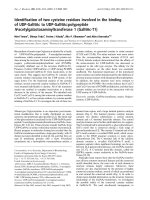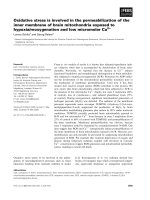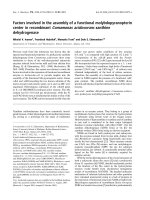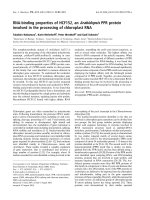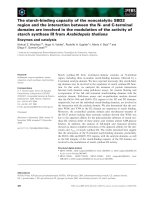Risks Involved in the Use of Herbal Products
Bạn đang xem bản rút gọn của tài liệu. Xem và tải ngay bản đầy đủ của tài liệu tại đây (244.17 KB, 15 trang )
Chapter 14
Risks Involved in the Use of Herbal Products
Peter B. Kaufman, Maureen McKenzie, and Ara Kirakosyan
Abstract The use of different herbal products can involve several kinds of risks
that include improper labeling or failure to provide the correct constituents; inad-
equate testing of the herbal product in clinical trials; failure to provide the stated
amounts of active constituents; contraindications between known herbs and syn-
thetic prescription drugs used to treat the same disease; overdosing or underdos-
ing; contamination of herbal preparations with pathogens, pesticides, and heavy
metals; expired shelf life; and problems with formulations that render them inef-
fective (e.g., ineffective dried preps in capsules versus effective formulations
taken as tinctures). In this chapter, we shall address many of these issues. They
are basically issues of quality control that involve the latest advances in plant
biotechnology.
14.1 Compromised Quality in the Preparation
of Herbal Medicines
Herbs to be grown for the preparation of herbal medicines can be compromised in
their quality for the following reasons:
• Herbs obtained from different sources (countries, regions, and growers) are
mixed in order to make commercial preparations.
• Herbs are not grown under uniform field or greenhouse conditions from year to
year.
• Herbs are not collected at the optimum stage of development.
• Herbs collected are adulterated with other herbs, some of which may be toxic or
devoid of the same biological activity.
P.B. Kaufman (
B
)
University of Michigan, Ann Arbor MI 48109-0646, USA
e-mail:
347
A. Kirakosyan, P.B. Kaufman, Recent Advances in Plant Biotechnology,
DOI 10.1007/978-1-4419-0194-1_14,
C
Springer Science+Business Media, LLC 2009
348 P.B. Kaufman et al.
• Processing of herbs after collection (e.g., drying or freeze-drying) is not uni-
form. Herbs are often sun-dried in the field and, as a result, lose much of their
potency.
• Processed herbs are not packaged or stored properly before commercial sale.
• Herbs are adulterated with other constituents (e.g., preservatives and fillers) when
packaged for commercial sale.
In order to mitigate these problems, growers and processors need to use standard
conditions and guidelines for growing, harvesting, formulating, and packaging of
herbal preparations. Good sources for this kind of information are found in Ody
(1993) and Moore (1995).
14.2 Inadequate Testing of Herbal Medicine Products
Many medicinal herbs have not yet been subjected to testing in human clinical trials.
Instead, they are promulgated for use based on animal (nonhuman) models or based
on oral tradition or practices of shamans.
Even if human clinical trials are conducted, they can suffer from improper design.
For example, this can include the following:
• Failure to use a double-blind, placebo-controlled, randomized clinical trial pro-
tocol.
• Failure to include greater than a single biologically active dose. The best judg-
ment here is to include half optimum, optimum, and twice optimum levels/doses
of the herb.
• Failure to include a sufficient number of time points to do good kinetics or to
obtain meaningful data.
• Failure to carry out the study for a sufficient length of time. This is especially crit-
ical for many herbal preparations, which often tend to be slow acting or require
administration of prescribed doses over an extended period of time (not hours or
days, but weeks).
14.3 Risks in the Use of Medicinal Herbs
The use of medicinal herbs to treat specific human disease can involve risks,
especially when used in combination with different kinds of synthetically pro-
duced prescription drugs. Patients taking herbal medicines as well as prescrip-
tion drugs to treat a specific ailment must consult their doctor before using such
combinations.
Examples (cited in The Merck Manual of Medical Information, second home edi-
tion, 2004, by Mark H. Beers) of such adverse interactions are given in Table 14.1.
14 Risks Involved in the Use of Herbal Products 349
Table 14.1 Some possible medicinal herb–drug interactions
Medicinal herb Affected drugs Interaction
Chamomile Anticoagulants (such as warfarin) Chamomile taken with
anticoagulants may increase the
risk of bleeding
Barbiturates (such as
phenobarbital) and other
sedatives
Chamomile may intensify or
prolong the effects of sedatives
Iron Chamomile may reduce iron
absorption
Echinacea Drugs that can damage the liver
(such as anabolic steroids,
amiodarone, methotrexate, and
ketoconazole)
Echinacea taken for more than 8
weeks may damage the liver.
When echinacea is taken with
another drug that can damage
the liver, the risk of liver
damage may be increased
Immunosuppressants (such as
corticosteroids and
cyclosporine)
By stimulating the immune system,
echinacea may negate the effects
of immunosuppressants
Feverfew Anticoagulants (such as warfarin) Feverfew taken with
anticoagulants may increase the
risk of bleeding
Iron Feverfew may reduce iron
absorption
Drugs used to manage migraine
headaches (such as ergotamine)
Feverfew may increase heart rate
and blood pressure when it is
taken with drugs used to manage
migraine headaches
Nonsteroidal anti-inflammatory
drugs (NSAIDs)
NSAIDs reduce the effectiveness
of feverfew in preventing and
managing migraine headaches
Garlic Anticoagulants (such as warfarin) Garlic taken with anticoagulants
may increase the risk of
bleeding
Drugs that decrease blood sugar
levels (hypoglycemic drugs such
as insulin and glipizide)
Garlic may intensify the effects of
these drugs, causing an
excessive decrease in blood
sugar levels (hypoglycemia)
Saquinavir (used to treat HIV
infection)
Garlic decreases blood levels of
saquinavir, making it less
effective
Ginger Anticoagulants (such as warfarin) Ginger taken with anticoagulants
may increase the risk of
bleeding
Ginkgo Anticoagulants (such as warfarin),
aspirin, and other NSAIDs
Ginkgo taken with anticoagulants
or with aspirin or other NSAIDs
may increase the risk of
bleeding
Anticonvulsants (such as
phenytoin)
Ginkgo may reduce the
effectiveness of anticonvulsants
in preventing seizures
350 P.B. Kaufman et al.
Table 14.1 (continued)
Medicinal herb Affected drugs Interaction
Monoamine oxidase
inhibitors (MAOIs, a type
of antidepressant)
Ginkgo may intensify the effects of
these drugs and increase the risk of
side effects, such as headache,
tremors, and manic episodes
Ginseng Anticoagulants (such as
warfarin), aspirin, and
other NSAIDs
Ginseng taken with anticoagulants or
with aspirin or other NSAIDs may
increase the risk of bleeding
Drugs that decrease blood
sugar levels
(hypoglycemic drugs)
Ginseng may intensify the effects of
these drugs, causing an excessive
decrease in blood sugar levels
(hypoglycemia)
Corticosteroids Ginseng may intensify the side effects
of corticosteroids
Digoxin Ginseng may increase digoxin levels
Estrogen replacement
therapy
Ginseng may intensify the side effects
of estrogen
MAOIs Ginseng can cause headache, tremors,
and manic episodes when it is
taken with MAOIs
Opioids (narcotics) Ginseng may reduce the effectiveness
of opioids
Goldenseal Anticoagulants (such as
warfarin)
Goldenseal may oppose the effects of
anticoagulants and may increase
the risk of blood clots
Licorice Antihypertensives Licorice may increase salt and water
retention and increase blood
pressure, making antihypertensives
less effective
Antiarrhythmics Licorice may increase the risk of an
abnormal heart rhythm, making
antiarrhythmic therapy less
effective
Digoxin Because licorice increases urine
formation, it can result in low levels
of potassium, which is excreted in
urine. When licorice is taken with
digoxin, the low potassium levels
increase the risk of digoxin toxicity
Diuretics Licorice may intensify the effects of
most diuretics, causing increased,
rapid loss of potassium. Licorice
may interfere with the effectiveness
of potassium-sparing diuretics,
such as spironolactone, making
these diuretics less effective
MAOIs Licorice may intensify the effects of
these drugs and increase the risk of
side effects, such as headache,
tremors, and manic episodes
14 Risks Involved in the Use of Herbal Products 351
Table 14.1 (continued)
Medicinal herb Affected drugs Interaction
Milk thistle Drugs that decrease blood sugar
levels (hypoglycemic drugs)
Milk thistle may intensify the
effects of these drugs, causing
an excessive decrease in blood
sugar levels
Saquinavir Milk thistle decreases blood levels
of saquinavir, making it less
effective
Saw palmetto Estrogen replacement therapy and
oral contraceptives
Saw palmetto may intensify the
effects of these drugs
St. John’s wort Benzodiazepines St. John’s wort may reduce the
effectiveness of these drugs in
reducing anxiety and may
increase drowsiness and the risk
of side effects such as
drowsiness
Cyclosporine St. John’s wort may reduce blood
levels of cyclosporine, making it
less effective, with potentially
dangerous results (such as
rejection of an organ transplant)
Digoxin St. John’s wort may reduce blood
levels of digoxin, making it less
effective, with potentially
dangerous results
Indinavir (a drug used to treat
AIDS)
St. John’s wort may reduce blood
levels of indinavir, making it
less effective
Iron St. John’s wort may reduce iron
absorption
MAOIs St. John’s wort may intensify the
effects of MAOIs, possibly
causing very high blood
pressure that requires
emergency treatment
Photosensitizing drugs (such as
lansoprazole, omeprazole,
piroxicam, and sulfonamide
antibiotics)
When taken with these drugs,
St. John’s wort may increase the
risk of sun sensitivity
Selective serotonin reuptake
inhibitors (such as fluoxetine,
paroxetine, and sertraline)
St. John’s wort may intensify the
effects of these drugs
Warfarin St. John’s wort may reduce blood
levels of warfarin, making it less
effective and clot formation
more likely
Valerian Anesthetics Valerian may prolong sedation
time
Barbiturates Valerian may intensify the effects
of barbiturates, causing
excessive sedation
352 P.B. Kaufman et al.
14.3.1 Medical Risks in the Use of Kava Kava (Piper
methysticum): A Case Study
Kava kava is a herbal ingredient derived from the plant Piper methysticum G. Forst.,
which is a member of the pepper family (Piperaceae). It is native to many Pacific
Ocean islands. The leaves and the root of the plant are used in herbal food and
medicinal products. In recent years it has become popular in Europe in herbal reme-
dies used to treat anxiety, tension, and restlessness.
It is considered a sacred plant by many of the traditional Polynesian cultures and
has been used in prayer and ritual as well as for a wide variety of ailments ranging
from asthma and rheumatism to weary muscles and sleeplessness. The main active
components in kava kava (kavalactones) are found in the root of the plant. Kavalac-
tones are thought to affect levels of neurotransmitters in the blood, which can affect
the body’s fight-or-flight response. While kava root was traditionally chewed or
made into a beverage, it is now primarily taken as a natural anxiety remedy in cap-
sule, tablet, beverage, tea, and liquid extract forms.
Evidence has mounted that in rare cases the use of products containing kava
kava (mostly in the form of herbal medicines) has been associated with severe liver
damage. Research indicates that this may be largely due to the use of stems and
leaves in dietary supplements, which were not used indigenously. The occurrence of
liver damage is unpredictable and the mechanism is unclear. Some of the compounds
found in Kava extracts block several subtypes of the enzyme cytochrome P450,
which may result in adverse interactions with concomitant use of other drugs and
alcohol (Mathews et al., 2002). Because of these reports, regulatory agencies in
Europe and Canada now warn consumers of the potential risks associated with kava
kava and even remove kava-containing products from the market. Based on these
and other reports in the United States, the Food and Drug Administration (FDA)
issued a consumer advisory in March of 2002 regarding the “rare” but potential risk
of liver failure associated with kava-containing products.
14.3.2 Medical Risks in the Use of Ephedra (Ephedra sinica):
A Case Study (Modified from Data Provided
by www.rand.org/health)
The herb ephedra, also known as ma huang (Ephedra sinica Stapf.), is a small
shrub native to Asia, where it has a long history of medicinal use, as documented
in ancient medical treatises from India and China. In traditional Chinese and Indian
medicine, branches of the herb are used to treat colds, and it is also used as a diuretic.
Modern European practitioners of herbal medicine use ephedra only to treat symp-
toms of respiratory diseases, such as bronchial asthma.
In the United States, the active components of ephedra are known as ephedrine
alkaloids. They include ephedrine, pseudoephedrine, and norephedrine (also
known as phenylpropanolamine and norpseudoephedrine). These constituents are




